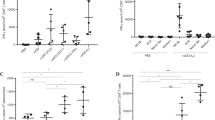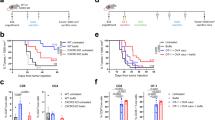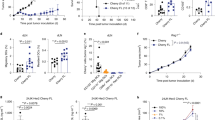Abstract
Type 1 T cells are the major components in antitumor immunity. The lack of efficient CD8+ cytotoxic T (Tc) cell infiltration of tumors is a major obstacle to adoptive Tc-cell therapy. We have previously demonstrated that adenovirus (AdV)-mediated transgene lymphotactin (Lptn) expression by intratumoral AdVLptn injection and intravenous CD4+ helper T (Th) cell transfer can enhance Tc-cell tumor infiltration and eradication of early stage tumors (5 mm in diameter). In this study, we generated ovalbumin (OVA)-specific Tc1 and Th1 cells in vitro by incubation of OVA-pulsed dendritic cells with naïve T cells from T-cell receptor (TCR) transgenic OT I and OT II mice. We then investigated the potential synergy of Th1 help effect and Lptn transgene expression in Tc1-cell therapy of well-established OVA-expressing EG7 solid tumors (7 mm in diameter). Our data showed that a combined adoptive T-cell therapy of Th1 (2.5 × 106 cells per mouse) and Tc1 (5 × 106 cells per mouse) resulted in regression of all eight (100%) transgene Lptn expressed EG7 tumors, which is significantly higher than four from eight (50%) in AdVLptn/Tc1 group and two from eight (25%) in Tc1/Th1 group (P<0.05). The amount of transferred Tc1 cells detected in Lptn-expressed tumors with Th1 treatment is 0.72%, which is significantly higher than those of AdVLptn (0.22%), Th1 (0.41%) and the control AdVpLpA (0.09%) treatment groups (P<0.05). Enhanced Tc1 tumor localization may be derived from the chemotactic effect of Lptn and the proliferative effect of Th1 and Lptn. This novel therapeutic strategy with enhancement of Tc1 tumor localization in the therapy of well-established tumors may become a tool of considerable conceptual interest in the implementation of future clinical objectives.
This is a preview of subscription content, access via your institution
Access options
Subscribe to this journal
Receive 12 print issues and online access
$259.00 per year
only $21.58 per issue
Buy this article
- Purchase on Springer Link
- Instant access to full article PDF
Prices may be subject to local taxes which are calculated during checkout








Similar content being viewed by others
References
Tanaka H et al. Successful adoptive immunotherapy of murine poorly immunogenic tumor with specific effector cells generated from gene-modified tumor-primed lymph node cells. J Immunol 1999; 162: 3574–3582.
Plautz GE, Touhalisky JE, Shu S . Treatment of murine gliomas by adoptive transfer of ex vivo activated tumor-draining lymph node cells. Cell Immunol 1997; 178: 101–107.
Peng L, Shu S, Krauss JC . Treatment of subcutaneous tumor with adoptively transferred T cells. Cell Immunol 1997; 178: 24–32.
Kjaergaard J, Shu S . Tumor infiltration by adoptively transferred T cells is independent of immunologic specificity but requires down-regulation of L-selectin expression. J Immunol 1999; 163: 751–759.
Mukai S, Kjaergaard J, Shu S, Plautz GE . Infiltration of tumors by systemically transferred tumor-reactive T lymphocytes is required for antitumor efficacy. Cancer Res 1999; 59: 5245–5249.
Croft M, Carter L, Swain SL, Dutton RW . Generation of polarized antigen-specific CD8 effector populations: reciprocal action of interleukin (IL)-4 and IL-12 in promoting type 2 versus type 1 cytokine profiles. J Exp Med 1994; 180: 1715–1728.
Carter LL, Dutton RW . Type 1 and type 2: a fundamental dichotomy for all T-cell subsets. Curr Opin Immunol 1996; 8: 336–342.
Cerwenka A et al. In vivo persistence of CD8 polarized T cell subsets producing type 1 or type 2 cytokines. J Immunol 1998; 161: 97–105.
Sad S, Kagi D, Mosmann TR . Perforin and Fas killing by CD8+ T cells limits their cytokine synthesis and proliferation. J Exp Med 1996; 184: 1543–1547.
Fowler DH et al. Allospecific CD8+ Tc1 and Tc2 populations in graft-versus-leukemia effect and graft-versus-host disease. J Immunol 1996; 157: 4811–4821.
Carter LL, Dutton RW . Relative perforin- and Fas-mediated lysis in T1 and T2 CD8 effector populations. J Immunol 1995; 155: 1028–1031.
Dobrzanski MJ, Reome JB, Dutton RW . Therapeutic effects of tumor-reactive type 1 and type 2 CD8+ T cell subpopulations in established pulmonary metastases. J Immunol 1999; 162: 6671–6680.
Dobrzanski MJ, Reome JB, Dutton RW . Type 1 and type 2 CD8+ effector T cell subpopulations promote long-term tumor immunity and protection to progressively growing tumor. J Immunol 2000; 164: 916–925.
Helmich BK, Dutton RW . The role of adoptively transferred CD8T cells and host cells in the control of the growth of the EG7 thymoma: factors that determine the relative effectiveness and homing properties of Tc1 and Tc2 effectors. J Immunol 2001; 166: 6500–6508.
Mosmann TR et al. Two types of murine helper T cell clone. I. Definition according to profiles of lymphokine activities and secreted proteins. J Immunol 1986; 136: 2348–2357.
Mosmann TR, Sad S . The expanding universe of T-cell subsets: Th1, Th2 and more. Immunol Today 1996; 17: 138–146.
Fernando GJ, Stewart TJ, Tindle RW, Frazer IH . Th2-type CD4+ cells neither enhance nor suppress antitumor CTL activity in a mouse tumor model. J Immunol 1998; 161: 2421–2427.
Goedegebuure PS, Eberlein TJ . The role of CD4+ tumor-infiltrating lymphocytes in human solid tumors. Immunol Res 1995; 14: 119–131.
Huang H, Li F, Gordon JR, Xiang J . Synergistic enhancement of antitumor immunity with adoptively transferred tumor-specific CD4+ and CD8+ T cells and intratumoral lymphotactin transgene expression. Cancer Res 2002; 62: 2043–2051.
Fearon ER et al. Interleukin-2 production by tumor cells bypasses T helper function in the generation of an antitumor response. Cell 1990; 60: 397–403.
Bennett SR et al. Help for cytotoxic-T-cell responses is mediated by CD40 signalling. Nature 1998; 393: 478–480.
Schoenberger SP et al. T-cell help for cytotoxic T lymphocytes is mediated by CD40–CD40L interactions. Nature 1998; 393: 480–483.
Ridge JP, Di Rosa F, Matzinger P . A conditioned dendritic cell can be a temporal bridge between a CD4+ T-helper and a T-killer cell. Nature 1998; 393: 474–478.
Marzo AL, Lake RA, Robinson BW, Scott B . T-cell receptor transgenic analysis of tumor-specific CD8 and CD4 responses in the eradication of solid tumors. Cancer Res 1999; 59: 1071–1079.
Marzo AL et al. Tumor-specific CD4+ T cells have a major ‘post-licensing’ role in CTL mediated anti-tumor immunity. J Immunol 2000; 165: 6047–6055.
Kelner GS et al. Lymphotactin: a cytokine that represents a new class of chemokine. Science 1994; 266: 1395–1399.
Lillard Jr JW et al. Lymphotactin acts as an innate mucosal adjuvant. J Immunol 1999; 162: 1959–1965.
Huang H et al. Neutrophils and B cells express XCR1 receptor and chemotactically respond to lymphotactin. Biochem Biophys Res Commun 2001; 281: 378–382.
Hogquist KA et al. T cell receptor antagonist peptides induce positive selection. Cell 1994; 76: 17–27.
Foulds KE et al. Cutting edge: CD4 and CD8T cells are intrinsically different in their proliferative responses. J Immunol 2002; 168: 1528–1532.
Li M et al. Cell-associated ovalbumin is cross-presented much more efficiently than soluble ovalbumin in vivo. J Immunol 2001; 166: 6099–6103.
Xiang J, Moyana T . Regression of engineered tumor cells secreting cytokines is related to a shift in host cytokine profile from type 2 to type 1. J Interferon Cytokine Res 2000; 20: 349–354.
Russell JH, Ley TJ . Lymphocyte-mediated cytotoxicity. Annu Rev Immunol 2002; 20: 323–370.
Huang H, Liu Y, Xiang J . Synergistic effect of adoptive T-cell therapy and intratumoral interferon gamma-inducible protein-10 transgene expression in treatment of established tumors. Cell Immunol 2002; 217: 12–22.
Becker C et al. Adoptive tumor therapy with T lymphocytes enriched through an IFN-gamma capture assay. Nat Med 2001; 7: 1159–1162.
Ogawa M et al. A critical role for a peritumoral stromal reaction in the induction of T-cell migration responsible for interleukin-12-induced tumor regression. Cancer Res 1999; 59: 1531–1538.
Rosenberg SA, Spiess P, Lafreniere R . A new approach to the adoptive immunotherapy of cancer with tumor-infiltrating lymphocytes. Science 1986; 233: 1318–1321.
Chang AE et al. Clinical observations on adoptive immunotherapy with vaccine-primed T-lymphocytes secondarily sensitized to tumor in vitro. Cancer Res 1993; 53: 1043–1050.
Chang AE et al. Adoptive immunotherapy with vaccine-primed lymph node cells secondarily activated with anti-CD3 and interleukin-2. J Clin Oncol 1997; 15: 796–807.
Pockaj BA et al. Localization of 111indium-labeled tumor infiltrating lymphocytes to tumor in patients receiving adoptive immunotherapy. Augmentation with cyclophosphamide and correlation with response. Cancer 1994; 73: 1731–1737.
Fisher B et al. Tumor localization of adoptively transferred indium-111 labeled tumor infiltrating lymphocytes in patients with metastatic melanoma. J Clin Oncol 1989; 7: 250–261.
Naito Y et al. CD8+ T cells infiltrated within cancer cell nests as a prognostic factor in human colorectal cancer. Cancer Res 1998; 58: 3491–3494.
Shields PL et al. Chemokine and chemokine receptor interactions provide a mechanism for selective T cell recruitment to specific liver compartments within hepatitis C-infected liver. J Immunol 1999; 163: 6236–6243.
Emtage PC et al. Adenoviral vectors expressing lymphotactin and interleukin 2 or lymphotactin and interleukin 12 synergize to facilitate tumor regression in murine breast cancer models. Hum Gene Ther 1999; 10: 697–709.
Yu P et al. Priming of naive T cells inside tumors leads to eradication of established tumors. Nat Immunol 2004; 5: 141–149.
Ossendorp F et al. Specific T helper cell requirement for optimal induction of cytotoxic T lymphocytes against major histocompatibility complex class II negative tumors. J Exp Med 1998; 187: 693–702.
Fallarino F et al. Th1 and Th2 cell clones to a poorly immunogenic tumor antigen initiate CD8+ T cell-dependent tumor eradication in vivo. J Immunol 2000; 165: 5495–5501.
Liu Y et al. Adenovirus-mediated CD40 ligand gene-engineered dendritic cells elicit enhanced CD8(+) cytotoxic T-cell activation and antitumor immunity. Cancer Gene Ther 2002; 9: 202–208.
Nishimura T et al. Distinct role of antigen-specific T helper type 1 (Th1) and Th2 cells in tumor eradication in vivo. J Exp Med 1999; 190: 617–627.
Chen Z et al. Enhanced HER-2/neu-specific antitumor immunity by cotransduction of mouse dendritic cells with two genes encoding HER-2/neu and alpha tumor necrosis factor. Cancer Gene Ther 2002; 9: 778–786.
Liu Y et al. Dendritic cells engineered to express the Flt3 ligand stimulate type I immune response, and induce enhanced cytoxic T and natural killer cell cytotoxicities and antitumor immunity. J Gene Med 2003; 5: 668–680.
Acknowledgements
This study was supported by research grant (MOP 67230) of the Canadian Institutes of Health Research to JX. We thank Mark Boyd for his excellent technical support of flow cytometric analysis.
Author information
Authors and Affiliations
Rights and permissions
About this article
Cite this article
Huang, H., Bi, X., Yuan, J. et al. Combined CD4+ Th1 effect and lymphotactin transgene expression enhance CD8+ Tc1 tumor localization and therapy. Gene Ther 12, 999–1010 (2005). https://doi.org/10.1038/sj.gt.3302486
Received:
Accepted:
Published:
Issue Date:
DOI: https://doi.org/10.1038/sj.gt.3302486
Keywords
This article is cited by
-
Treatment with targeted vesicular stomatitis virus generates therapeutic multifunctional anti-tumor memory CD4 T cells
Cancer Gene Therapy (2012)
-
Th17 and Th17-stimulated CD8+ T cells play a distinct role in Th17-induced preventive and therapeutic antitumor immunity
Cancer Immunology, Immunotherapy (2011)
-
Engineered CD8+ cytotoxic T cells with fiber-modified adenovirus-mediated TNF-α gene transfection counteract immunosuppressive interleukin-10-secreting lung metastasis and solid tumors
Cancer Gene Therapy (2007)



